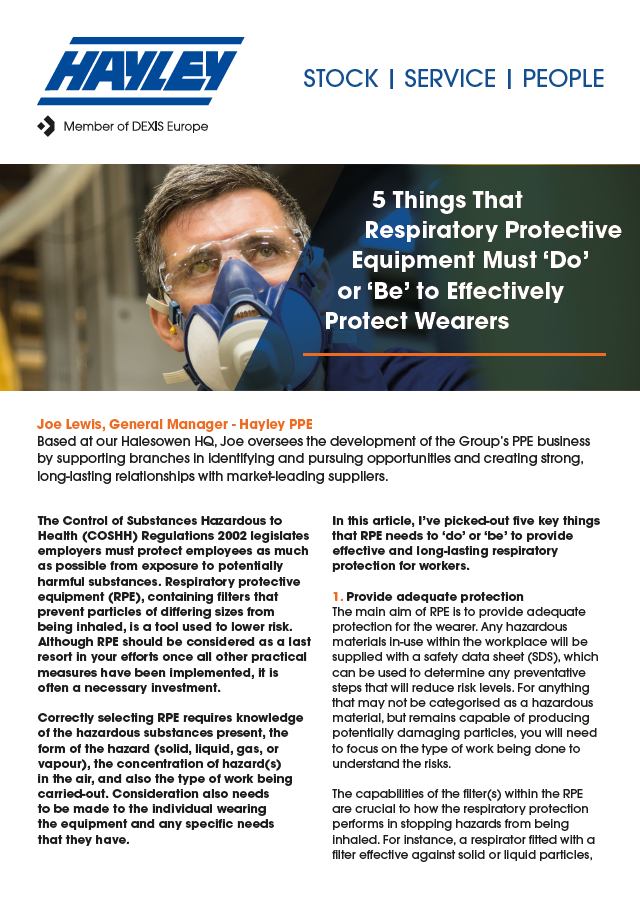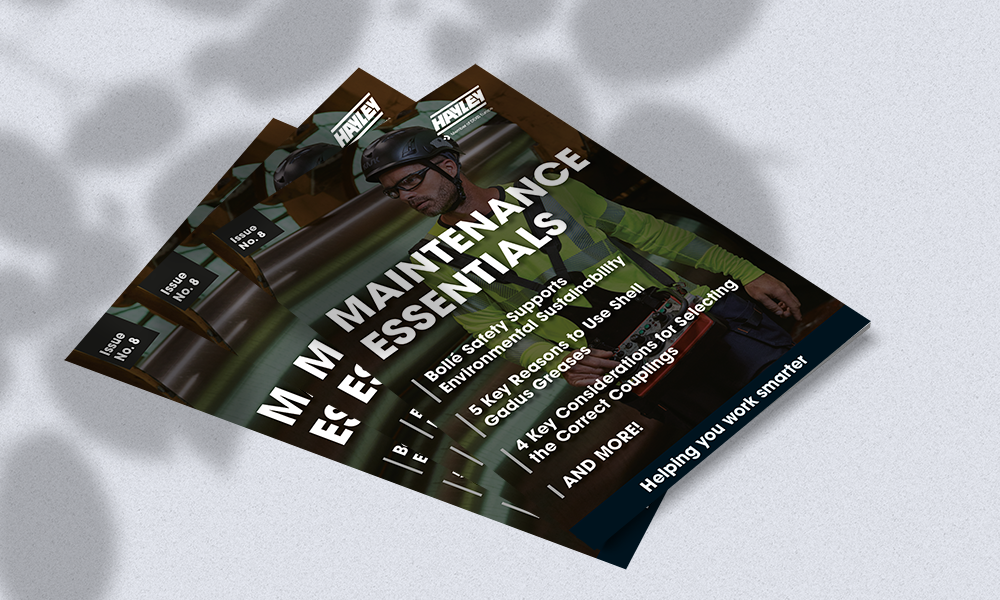Joe Lewis, General Manager - Hayley PPE
Based at our Halesowen HQ, Joe oversees the development of the Group’s PPE business by supporting branches in identifying and pursuing opportunities and creating strong, long-lasting relationships with market-leading suppliers.
The Control of Substances Hazardous to Health (COSHH) Regulations 2002 legislates employers must protect employees as much as possible from exposure to potentially harmful substances. Respiratory protective equipment (RPE), containing filters that prevent particles of differing sizes from being inhaled, is a tool used to lower the risk for personnel. Although RPE should be considered as a last resort in your efforts once all other practical measures have been implemented, it is often a necessary investment.
Obligatory risk assessments, conducted to meet COSHH regulations require employers to select adequate and suitable RPE for users coming into contact with relevant hazards at work.
In this article, I’ve picked-out five key things that RPE needs to ‘do’ or ‘be’ to provide effective and long-lasting respiratory protection for workers. These considerations can be vital to ensure you select both adequate and suitable protection.
1 Provide adequate protection
It goes without saying that the main aim of RPE must be to provide adequate protection for the wearer. Any hazardous materials in use at your workplace will be supplied with a safety data sheet (SDS), which can be used to quickly determine any recommended preventative steps that can be made to reduce the risks to the workforce. For anything that may not be categorised as a hazardous material, but still capable of producing potentially damaging particles, you will need to focus on the type of work being done to understand the risks.
The capabilities of the filter(s) within the RPE are crucial to how the respiratory protection performs in stopping respiratory hazards from penetrating the filters and being inhaled. For instance, a reusable respirator fitted with a filter effective against solid or liquid particles, wouldn’t provide any protection when hazardous gases and vapours are present.
The assigned protection factor (APF) of each RPE type and class indicates how much protection is offered. This protection factor will help you to decide on the most adequate protection for your needs, a process informed by any SDS documentation that you have.
It is recommended by the Health & Safety Executive (HSE) that you should select an APF above the calculated value of the volume of hazardous substance in the air, in order to ensure protection.¹
2. Be suitable for intended use
RPE must be suitable for the use in which it’s employed, and also meet all of the users’ requirements. Work activities such as grinding, sanding, cutting, paint spraying, welding, and the use of solvents can produce harmful respiratory hazards that release into the air. Once the form (solid, liquid, gas, or vapour) and concentration/volume (ppm / mg/m3) of the respiratory hazard has been identified, you can begin to narrow down the RPE options suitable for you.
RPE must not only be effective in filtering the contaminants present, it also needs to be suitable for the wearer. All tight fitting RPE should be Face Fit Tested to ensure that it fits to the wearers’ face. Wearers of tight fitting RPE should also be clean shaven where the respirator seals to their face. In addition, accessories such as glasses or piercings should not interfere with the fit. If the tight fitting RPE does not fit the wearer the protection provided will be compromised.
Suitability considerations for the wearer’s work rate, wear time, and vision requirements also needs thought. For instance, the HSE recommends that tight fitting respirators are only worn for an hour at a time during continued use, and if the work rate of the wearer is high, increased breathing and perspiration could impact their experience with the equipment.1 If wear time is required for over an hour continuously or work rate is medium to high then powered air systems may be a consideration. These types of systems can also be beneficial where environmental conditions such as temperature and humidity may mean tight fitting RPE is uncomfortable.
3. Be of an approved type/standard
RPE available for use in the UK must be manufactured in accordance with the Personal Protective Equipment Regulations (2002), and therefore bear the CE/UKCA mark. This mark signifies that the product has been assessed and found to meet high safety, health, and environmental protection requirements, deeming it fit for the European/UK markets respectively. Only products with these marks have been designed and tested to meet at least the minimum requirements laid out in law.
4. Be used correctly
The RPE provided to staff can only be effective if wearers have the appropriate level of awareness and knowledge to use the equipment correctly. It is the employer’s responsibility to arrange adequate training for RPE wearers, to ensure that employees are sufficiently protected at all times whenever there is a risk of hazardous contaminants being inhaled. Training sessions should not only cover the correct use of equipment, but also why RPE has been implemented as a safety measure, as well as how users should store, clean, maintain and dispose the products given to them.
5. Be properly stored and maintained
The appropriate storage, cleaning, and maintenance of RPE is critical in prolonging its service life, preserving its ability to protect its users whilst making the most out of the company’s investment in the equipment.
Manufacturer’s guidelines should be followed at all times, with regular checks conducted to ensure that these guidelines are being upheld. Reusable RPE should undergo inspection at recommended intervals, and any maintenance processes carried-out should be documented, with records retained for at least five years, as recommended by the HSE.¹
Hayley Group works in collaboration with market-leading PPE suppliers and manufacturers, such as 3M, to provide genuine and quality products for our customers. By purchasing your respiratory protection equipment through us, you get access to the best products available for your requirements and can be confident that they meet all relevant standards to keep personnel safe in the workplace at all times.
Speak to your local branch about your RPE requirements today!




